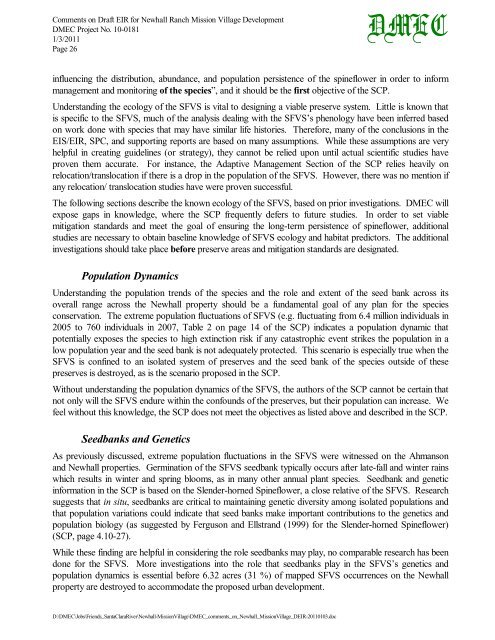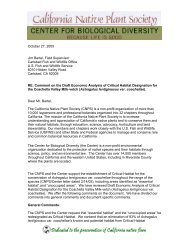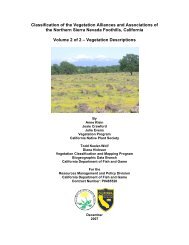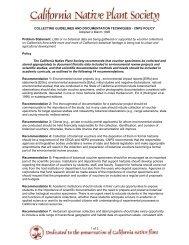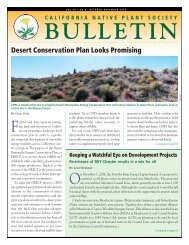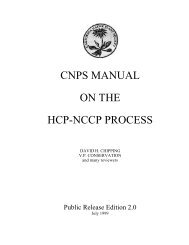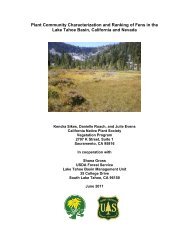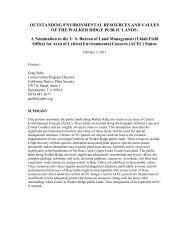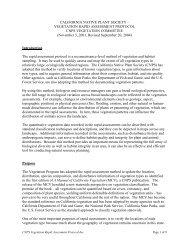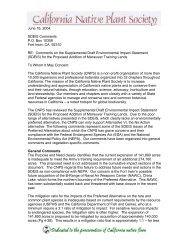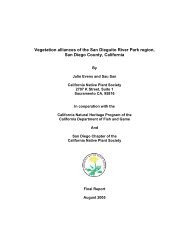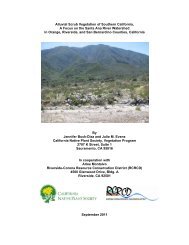David Magney Environmental Consulting - California Native Plant ...
David Magney Environmental Consulting - California Native Plant ...
David Magney Environmental Consulting - California Native Plant ...
You also want an ePaper? Increase the reach of your titles
YUMPU automatically turns print PDFs into web optimized ePapers that Google loves.
Comments on Draft EIR for Newhall Ranch Mission Village Development<br />
DMEC Project No. 10-0181<br />
1/3/2011<br />
Page 26<br />
D:\DMEC\Jobs\Friends_SantaClaraRiver\Newhall-MissionVillage\DMEC_comments_on_Newhall_MissionVillage_DEIR-20110103.doc<br />
DMEC<br />
influencing the distribution, abundance, and population persistence of the spineflower in order to inform<br />
management and monitoring of the species”, and it should be the first objective of the SCP.<br />
Understanding the ecology of the SFVS is vital to designing a viable preserve system. Little is known that<br />
is specific to the SFVS, much of the analysis dealing with the SFVS’s phenology have been inferred based<br />
on work done with species that may have similar life histories. Therefore, many of the conclusions in the<br />
EIS/EIR, SPC, and supporting reports are based on many assumptions. While these assumptions are very<br />
helpful in creating guidelines (or strategy), they cannot be relied upon until actual scientific studies have<br />
proven them accurate. For instance, the Adaptive Management Section of the SCP relies heavily on<br />
relocation/translocation if there is a drop in the population of the SFVS. However, there was no mention if<br />
any relocation/ translocation studies have were proven successful.<br />
The following sections describe the known ecology of the SFVS, based on prior investigations. DMEC will<br />
expose gaps in knowledge, where the SCP frequently defers to future studies. In order to set viable<br />
mitigation standards and meet the goal of ensuring the long-term persistence of spineflower, additional<br />
studies are necessary to obtain baseline knowledge of SFVS ecology and habitat predictors. The additional<br />
investigations should take place before preserve areas and mitigation standards are designated.<br />
Population Dynamics<br />
Understanding the population trends of the species and the role and extent of the seed bank across its<br />
overall range across the Newhall property should be a fundamental goal of any plan for the species<br />
conservation. The extreme population fluctuations of SFVS (e.g. fluctuating from 6.4 million individuals in<br />
2005 to 760 individuals in 2007, Table 2 on page 14 of the SCP) indicates a population dynamic that<br />
potentially exposes the species to high extinction risk if any catastrophic event strikes the population in a<br />
low population year and the seed bank is not adequately protected. This scenario is especially true when the<br />
SFVS is confined to an isolated system of preserves and the seed bank of the species outside of these<br />
preserves is destroyed, as is the scenario proposed in the SCP.<br />
Without understanding the population dynamics of the SFVS, the authors of the SCP cannot be certain that<br />
not only will the SFVS endure within the confounds of the preserves, but their population can increase. We<br />
feel without this knowledge, the SCP does not meet the objectives as listed above and described in the SCP.<br />
Seedbanks and Genetics<br />
As previously discussed, extreme population fluctuations in the SFVS were witnessed on the Ahmanson<br />
and Newhall properties. Germination of the SFVS seedbank typically occurs after late-fall and winter rains<br />
which results in winter and spring blooms, as in many other annual plant species. Seedbank and genetic<br />
information in the SCP is based on the Slender-horned Spineflower, a close relative of the SFVS. Research<br />
suggests that in situ, seedbanks are critical to maintaining genetic diversity among isolated populations and<br />
that population variations could indicate that seed banks make important contributions to the genetics and<br />
population biology (as suggested by Ferguson and Ellstrand (1999) for the Slender-horned Spineflower)<br />
(SCP, page 4.10-27).<br />
While these finding are helpful in considering the role seedbanks may play, no comparable research has been<br />
done for the SFVS. More investigations into the role that seedbanks play in the SFVS’s genetics and<br />
population dynamics is essential before 6.32 acres (31 %) of mapped SFVS occurrences on the Newhall<br />
property are destroyed to accommodate the proposed urban development.


